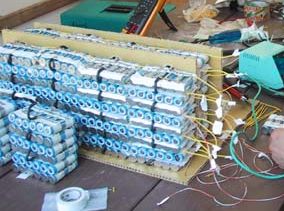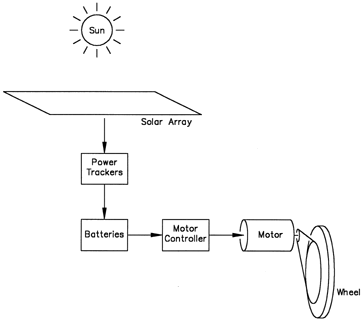|
SOLAR CAR ELECTRICAL SYSTEM
|
||||||||||||||||
|
HOME | AUTOMOTIVE | BLUEPLANET | ELECTRIC CARS | FORMULA E | ENERGY | INSURANCE | INDEX | SOLAR CARS |
||||||||||||||||
|
At the heart of any solar powered car, must be the electrical system. This comprises the batteries and power electronics to control and manages all the power that enters and exits the system - solar arrays to supply and motor as the end user.
The battery pack is equivalent to a petrol tank in a conventional IC car. A solar car uses the battery pack to store energy that will be used at some later time and also as a load leveling device. Solar cars start races with fully charged battery packs, but after the start, only energy generated by the solar array can be used to recharge the batteries. The maximum amount of batteries that a team can use is limited by a weight rule that is set for each battery type. The most commonly used batteries are:
NiCad, NiMH, and Lithium batteries offer improved power to weight ratio over the more common Lead-Acid batteries, but they are less proven technologies that require careful maintenance and are more costly. Although, in recent years the price has dropped and the reliability is much improved.
Nickel-Metal Hydrid (NiMH)
The battery pack is made up of several individual cells or modules wired together to generate the required system voltage. The word "battery" comes from a number of guns, "a battery", put together. Commonly, teams use system voltages between 84 and 108 volts, depending on their electrical system. Some teams run lower 48 or 60 volt systems. Obviously, the higher the voltage, the more complex the pack and possibly the array. Equally, higher voltages usually means better overall system efficiency.
Some of the most sophisticated components in a solar car are the power electronics. They include the peak power trackers, the motor controller, and the data acquisition system. The primary function of the power electronics is to monitor and control the electricity within the system. Most teams purchase their power electronic components off the shelf these days. Some teams commission custom built components or build their own custom components.
The peak power trackers condition the electricity coming from the solar array to maximize the power and deliver it either to the batteries for storage or to the motor controller for propulsion. When the solar array is charging the batteries, the peak power trackers help to protect the batteries from being damaged by overcharging. The number of peak power trackers used in a solar car varies with each team's design. Peak power trackers can be very lightweight and commonly reach efficiencies above 95%.
Peak power trackers
The motor controller handles the electricity being sent to the motor based on input signals coming from the driver's accelerator. The power electronics used to manage the electricity within the motor controller is a subject for technical explanations beyond the scope of this general introduction to the subject and is like most specific areas of design, a specialist subject. There are many different types of motor controllers to work with different types a motors. For the teams that purchase their motors, they can usually also buy a controller that is designed to work with that motor. All teams use some type of motor controller and the best ones are more than 90% efficient. Some are DC controllers and some AC controllers.
Many competitors now use sophisticated data acquisition systems that monitor the entire electrical system including the solar array, batteries, motor controller and motor. A team needs to monitor the battery voltage and current as the basic minimum. The data received from the acquisition system may be very useful in planning your teams race strategy. This information could also head off potential problems developing in the car. Ultimately, the driver must interpret his instruments and his support team monitor their car remotely using telemetry (wireless data transmission).
Please click on the links above to find out about these famous automotive makers. If your company is not included and you would like to be listed, please let us know.
UK VEHICLE INSURANCE ONLINE A - Z
A taste for adventure capitalists
SMARTCHARGER - Potentially the world's fastest electric car: 400mph using energy from nature. Featuring built in battery swapping system, charged using renewable solar energy. A project in waiting in PR terms.
|
||||||||||||||||
|
The
content of this website is copyright © 1991 and 2019 Electrick
Publications. All rights reserved. The bluebird logo
|
||||||||||||||||


